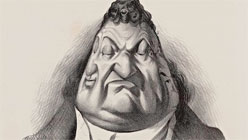There’s been a lot of buzz lately, at least among people I talk to, about a pair of exhibitions focusing on the protest art of Occupy and the graphics that accompanied the social-justice movement of the 1960s. The first show is Occupy Bay Area at the Yerba Buena Center for the Arts in San Francisco through October 14, 2012. The second is All of Us or None: Social Justice Posters of the San Francisco Bay Area, which closes on August 19, 2012, at the Oakland Museum of California.
I wrote about the connection between the artwork produced by these two movements back in March for Collectors Weekly, but after seeing When Artists Attack the King: Honoré Daumier and La Caricature, 1830–1835, now through November 11, 2012, at the Cantor Art Center on the Stanford campus, I’m beginning to think I didn’t go back far enough.

Honoré Daumier, Don’t You Meddle with It!!, 1834.
On view are 50 pieces of ephemera and lithographs disseminated in journals such as La Caricature, which was a persistent thorn in the side of Louis-Philippe I of France, who assumed the throne after the Revolution of 1830. Published by Charles Philipon and printed by Delaporte, La Caricature promoted work that actually put people in jail, from its printer and publisher to one of its leading artists, Honoré Daumier. Finally fed up with the 450 or so unflattering caricatures of himself in La Caricature, Louis-Philippe shuttered the publication in 1835.
Daumier gets billing in the show’s title because of his marquee name and body of work — during his life, he created more than 4,000 lithographs. And importantly to this exhibition, he was a master of both caricature and portraiture, as seen in a lithograph titled Don’t You Meddle with It!!. In the foreground stands a printer atop the words “Liberté de la Press” (Freedom of the Press), sledgehammer fists clenched at his sides. Behind him is a beaten Charles X, who was toppled by the Revolution of 1830, while to his right is Louis-Philippe, face hidden by his outstretched arm as a minister tries to restrain him, lest he make the same mistake as his predecessor.






